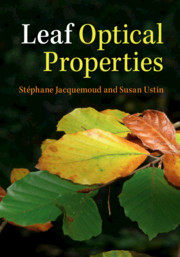
-
Select format
-
- Publisher:
- Cambridge University Press
- Publication date:
- 19 August 2019
- 05 September 2019
- ISBN:
- 9781108686457
- 9781108481267
- Dimensions:
- (247 x 174 mm)
- Weight & Pages:
- 1.32kg, 566 Pages
- Dimensions:
- Weight & Pages:
You may already have access via personal or institutional login
Book description
Plant leaves collectively represent the largest above-ground surface area of plant material in virtually all environments. Their optical properties determine where and how energy and gas exchange occurs, which in turn drives the energy budget of the planet, and defines its ecology and habitability. This book reviews the state-of-the-art research on leaf optics. Topics covered include leaf traits, the anatomy and structure of leaves, leaf colour, biophysics and spectroscopy, radiometry, radiative transfer models, and remote and proximal sensing. A physical approach is emphasised throughout, providing the necessary foundations in physics, chemistry and biology to make the context accessible to readers from various subject backgrounds. It is a valuable resource for advanced students, researchers and government agency practitioners in remote sensing, plant physiology, ecology, resource management and conservation.
Reviews
'This advanced book considers the optical properties of leaves from many perspectives, including biophysical, biochemical, molecular, physiological, and ecological. Author Jacquemoud (Univ. of Paris) is a professor of remote sensing and a physicist, while Ustin (Univ. of California Davis) is a professor of environmental resource science. Together they bring considerable expertise to this endeavor … This work will appeal to advanced students and researchers in plant physiology, as well as students and practitioners of remote sensing.’
J. Z. Kiss Source: Choice
‘If you are a plant ecologist, horticulturalist, plant anatomist, plant physiologist, plant developmental biologist, plant evolutionist, plant cell biologist, plant pathologist, biophysicist, biochemist, biosynthetic plant engineer, someone who does remote sensing, a historian of science, or someone interested in feeding the world, stop reading this review and buy this book. The authors write so that readers specialized in any one discipline will understand the material presented in all other disciplines.’
Randy Wayne Source: The Quarterly Review of Biology
Contents
Metrics
Altmetric attention score
Full text views
Full text views help Loading metrics...
Loading metrics...
* Views captured on Cambridge Core between #date#. This data will be updated every 24 hours.
Usage data cannot currently be displayed.
Accessibility standard: Unknown
Why this information is here
This section outlines the accessibility features of this content - including support for screen readers, full keyboard navigation and high-contrast display options. This may not be relevant for you.
Accessibility Information
Accessibility compliance for the PDF of this book is currently unknown and may be updated in the future.


